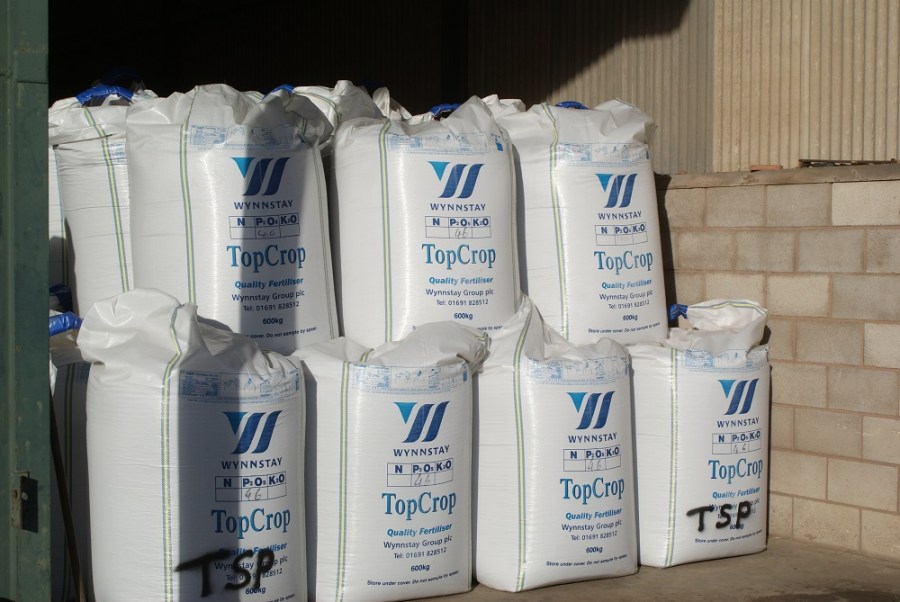Phosphate is the most difficult major plant nutrient when it comes to understanding how it behaves in the soil. CPM finds out about the latest research that may eventually lead to more efficient use of phosphate fertilisers.
Nothing moves fast with phosphate.
By Lucy de la Pasture
Managing levels of P in soils has been very much like managing a bank account – trying to keep a fairly healthy credit balance to avoid the cost of going overdrawn. But problems with the amount of phosphate in water means management of the nutrient needs a rethink. AHDB-funded research has been looking at the possibility of farming with less credit in the soil bank account.
Dr Sajjad Awan, AHDB resource management scientist, says the AHDB has already funded around £1M of research on phosphate over the past 12 years, which may prove prudent given the Government’s pledge to make agriculture greener. Price volatility due to political instability in North Africa, where much of the phosphate used in fertiliser is produced, is another good reason to refine the research to see if less reliance can be placed on maintaining soil P indices, he explains.
Prof Roger Sylvester-Bradley, ADAS head of crop performance, has been leading the phosphate research, which has revealed some interesting facts and sometimes puzzling behaviour, where P indices haven’t always behaved as expected, he explains.
“There’s a strong relationship between the P indices of soils and the amount of soluble reactive P found in drainage and surface water,” says Roger. “The dominant cause of agricultural failures in water quality are due to excessive amounts of soluble phosphate so we’re looking for solutions. The target amount for soluble phosphate in water under the EU Water Framework Directive is 30ppb and when soil indices are 2 or more, it’s very difficult to get phosphate levels in water low enough to meet this upper limit, set to prevent eutrophication.”

There are concerns that water quality standards are difficult to meet when soils are maintained at Index 2 for P or above.
With 50% of UK soils at or above Index 2 and 80% having indices above 1, according to industry estimates, there’s a challenge ahead if water quality standards are to be met. One of the objectives of the research is to investigate the possibility of farming soils at Index 1 for phosphate, meaning many soils will need to run down their reserves.
“Nothing moves fast with phosphate,” says Roger. “That’s a good and bad thing. It gives us plenty of time to think about how to tackle the problem, but it also takes a long time to see any changes to phosphate levels in the soil. This makes research difficult and a lengthy process.”
One of the more startling facts to come out of the research is that the most common source of phosphate applied as fertiliser, triple super phosphate (TSP), is used very inefficiently by plants.
“The recovery rate of TSP by the first crop is just 4%. The vast majority of the phosphate applied goes into the reserves of fixed P in the soil, which is unavailable to plants and only released very slowly. One of the reasons we’ve farmed in a way that maintains soil indices at a reasonable level is so there’s always a reasonable level of fixed P, which in turn means a small amount of P is available to crops.”
To make the move to farming at index 1 for P without endangering yield, it’s important that if a crop is short of phosphate, any applied as fertiliser is able to be more efficiently recovered by plants, stresses Roger.
“Other forms of phosphate or fertiliser placement in the trial proved to be little better than TSP, with slow-releasing struvite performing best of all, providing a slightly more efficient uptake (up to 10%) and yield effects over and above treatment with TSP,” he explains.
Fertiliser efficiency at these rates could pose a problem to growers, who would be more dependent on fresh P if farming at a low soil index and it’s an area that Roger highlights as needing further investigation. Efficiency of other sources of phosphate such as monoammonium phosphate (MAP), diammonium phosphate and treated organic manures are worthy of assessment, he believes.
There are several ways of assessing how well a crop is supplied with phosphorus, he explains. “In order to improve confidence in soil P tests, we’ve been looking at crop analysis as an extra tool to help assess its uptake. Tissue analysis only provides a snapshot of the phosphate status on any one day, in contrast analysis of the grain provides a statement of the phosphate supply through the crop’s life.”
Although grain analysis only supplies a strategic rather than a tactical tool, Roger says that the measure has already given a surprising insight into the phosphorus status of crops in the Yield Enhancement Network (YEN).
“We started using grain analysis in the YEN two years ago and a quarter of samples have come back in the deficiency band for phosphorus, below threshold levels. Interestingly RB209 assumes 4000ppm of phosphorus in the grain but in the YEN, only 17% of samples have been above this level, with 83% lower and 24% apparently deficient in phosphorus (less than 3,200ppm).
“The assumptions in RB209 are based on work done in the 1980’s and 1990’s but the results of the YEN analysis, which are all well-managed and high yielding crops, indicates that RB209 overestimates the amount of phosphorus in grain,” he notes.
A further indication that RB209 overestimates the off-take of phosphate by crops was discovered in collaboration with precision-farming company Soyl, who supported analysis of their database.
“Soyl identified 36 farms within the database where no organic manures had been applied, giving a broad set of (6,500) data points. On these farms recommendations had been made according to RB209, which aims to replace phosphate removed by the crop and maintain soil indices at around 2. On examination the data showed that, over time, the majority of soil P indices were actually increasing, indicating that soil reserves were being inadvertently built up,” he explains.
So if many soils actually now need to run down their soil P indices, how long is this likely to take? The answer may not be as straightforward as previously thought, believes Roger.
“Rothamsted Research looked at three sites to assess how long available phosphorus levels take to run down and they found the half-life to be about nine years. ADAS have set up four more experiments at two sites in the East and two sites in the West, to see if the run-down rates are the same.”
And the results raise further unanswered questions, he points out. “In the East, both sites are more or less in-line with a half-life for phosphate of nine years. But in the West something different is happening – neither site has run down in the seven years the trial has been running.”
It’s worth noting that the testing methods for phosphate in soil are comparatively crude and provide a less certain result than for Mg, K and soil pH levels.
Precision farming can also assist with improving certainty by taking samples at the same sample points. “Precision farming gives more data about the levels of phosphate in the field and enables variable rate application to even up available supply. It also provides farm-specific information on how much phosphate it takes to build up or run down soil P,” he says.
By comparing these changes over time, it’s possible to establish a soil’s apparent phosphate requirement (ASPR) in kg/ha per mg/l soil. What has become apparent from looking at the data from SOYL is farms are very different in the way their soils react to phosphate.
“Interestingly it seems to be a farm effect rather than one that can be explained by soil type. Some take a lot of phosphate, some need less but on average they require less phosphate than is recommended within RB209.”
According to the nutrient bible RB209, 40kg/ha P205 (additions or removals) is needed to change soil P by 1mg/l but the ADAS work shows it’s actually half this figure, 20kg/ha per mg/l soil. What this means is that less phosphate is required than RB209 predicts to move the soil index, he explains.
Sajjad stresses that AHDB advice continues to be to maintain soil P index at 2, as per RB209 guidelines, but the results of the ongoing research will be used to refine recommendations when the nutrient guide is next revised in 2019-2020.
Potato plants typically don’t have root systems that are as extensive as those found in cereals, so it’s important to manage soil so that rooting isn’t impeded, says Dr Marc Allison, senior researcher at NIAB CUF.
“We’ve found occasional responses to applied phosphate at P Index 2 in potatoes, but no response at higher indices. The recommendation in RB209 to maintain soil P at index 2 for potatoes reflects this. If soil conditions are limiting, a response may be more likely at the higher soil indices,” he says.
Tramline trials take research onto the farm
As industry partners in the phosphate research led by ADAS, Frontier has been the bridge between scientists and the farm gate. The company’s national crop nutrition technical manager Edward Downing believes the series of tramline trials will provide information that’s highly relevant to growers, set up with large-scale plots using commercial farm machinery.
“The tramline trials are analysed using ADAS Agronōmics, which has been developed to provide meaningful statistics to on-farm research and goes way beyond the split-field comparisons that have previously been carried out on farms,” he explains.
The trials allow treatments to be fully replicated, and true statistical meaning attached to the results. The current tramline trials set up by Frontier have shown low significant differences (LSDs) meaning that statistically the results can be considered reliable.
In the autumn, four treatments were applied with an untreated control; placed phosphate at 20-30kg/ha P205; placed phosphate at 70kg/ha P205 and broadcast phosphate at 70kg/ha P205.
“The results are still being analysed but at some sites there were responses, whereas at others there were no responses even though the levels of soil phosphorus were at similar levels,” comments Edward.
This spring, further tramline trials are planned which will look at phosphate applied to spring crops and include DAP as well as TSP fertiliser, he adds.
“Phosphate is one of the most complex of all the nutrients because there are so many facets to its behaviour. It doesn’t move far in the soil, unlike potash, and its availability is strongly influenced by pH.
“The current system where we have a target P index and either build up or run down levels of soil P to achieve it, depending on crop offtakes and soil levels, is basic in its approach. But without really solid knowledge and an in-depth understanding of phosphate, we haven’t been able to develop anything better.
“All the ongoing phosphate work will help improve our understanding and how we should be managing the nutrient on the farm to maintain yield, yet also use it efficiently so that there’s as little environmental impact as possible,” he says.
Research round-up
AHDB project 2160004 – ‘Cost-effective phosphorus management on UK arable farms (Cost-effective P)’ – runs from Aug 2013 to Dec 2018. It aims to improve understanding of the factors affecting rates of change in soil P status, provide evidence on critical levels of soil P and determine the value of fresh P applications. Led by ADAS, with project partners Bangor University, NIAB TAG, Rothamsted Research, Soyl and Frontier, its total cost is £283,000, with £249,000 funded by AHDB. Final project conclusions will be published in AHDB Project Report 570.




